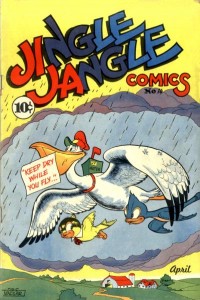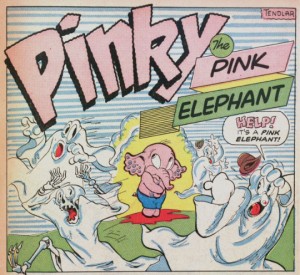It’s good to be back on Cartoon Research, everyone! This week’s post is dedicated to Dave Tendlar—an overlooked talent in the annals of theatrical animation.

Dave Tendlar in later years at Hanna Barbera
According to a “tintype” biography in Fleischer’s Animated News, Dave Tendlar was born in Dayton, Ohio in 1909. His family moved to New York in 1926. As a student attending Stivers High School, he displayed his talents drawing artwork for their newspaper. After he graduated, Tendlar received his first job in animation at Max Fleischer’s studio as a blackener on the Out of the Inkwell series with Koko the Clown. When Fleischer’s Inkwell studio disbanded, Tendlar moved to Charles Mintz’s studio, as an inker/opaquer on the Krazy Kat cartoons produced by Ben Harrison and Manny Gould. With the advent of sound, Mintz moved his animators to the West Coast. Tendlar stayed in New York and shifted to John McCrory’s studio, where he advanced his craft, working as an in-betweener and later, full-fledged animator.
 In 1931, Tendlar returned to Fleischer’s as an animator, mostly working with Willard Bowsky’s crew. Though there are intermittent credits with Tendlar as “head animator” in earlier titles—examples being Is My Palm Red and Betty Boop’s May Party, both from 1933—he wasn’t given his own unit until late 1934.
In 1931, Tendlar returned to Fleischer’s as an animator, mostly working with Willard Bowsky’s crew. Though there are intermittent credits with Tendlar as “head animator” in earlier titles—examples being Is My Palm Red and Betty Boop’s May Party, both from 1933—he wasn’t given his own unit until late 1934.
As “head animator” of several Popeye, Betty Boops and Color Classics, Tendlar was in charge of the timing, layout, character designs, and would often animate sections in his cartoons. When the Fleischer studio moved its operations to Miami in 1938, Tendlar went along, serving as an animator on Gulliver’s Travels (1939) and credited as a “director of animation” for Mr. Bug Goes to Town (1941). Tendlar returned to New York, as Paramount ousted Max and Dave Fleischer from their studio and re-established it as Famous Studios, by the end of 1942.
At Famous Studios, Tendlar’s films specialized in broad comedy, with the continuing Popeye series and the “Noveltoons,” which capitalized on the energy of the West Coast product, and featured Blackie the Lamb and solo appearances of Herman the Mouse during the 1940s. Besides his directorial duties at Famous, he also worked freelance on comic book work, mostly for Eastern Color Publishing’s Jingle Jangle Comics, drawing stories with small bird characters, Chauncey Chirp and Johnny Jay. Tendlar also extended his drawing to humans—for instance, twin siblings “Ginger and Snap” in Eastern’s teen magazine Club “16”.
 In the early 1950s, as studio producers Seymour Kneitel and Izzy Sparber retained “director” credits in the Famous cartoons, Tendlar was given his own credit. During this time, he drew another “funny animal” feature, Two-Bit the Wacky Woodpecker, for Toby Press. Tendlar also handled human characters in that magazine, the Western-themed “Tumbleweed Tim and Chuck.” After Famous signed a contract with Harvey Comics to use the animated Paramount characters, Tendlar decided to draw stories with them. However, with all of the tasks given to him as a director at Famous, he left the penciling duties to other artists, including Marty Taras.
In the early 1950s, as studio producers Seymour Kneitel and Izzy Sparber retained “director” credits in the Famous cartoons, Tendlar was given his own credit. During this time, he drew another “funny animal” feature, Two-Bit the Wacky Woodpecker, for Toby Press. Tendlar also handled human characters in that magazine, the Western-themed “Tumbleweed Tim and Chuck.” After Famous signed a contract with Harvey Comics to use the animated Paramount characters, Tendlar decided to draw stories with them. However, with all of the tasks given to him as a director at Famous, he left the penciling duties to other artists, including Marty Taras.
He left Famous around December 1956, moving over to Terrytoons—by that time purchased by CBS Television—as an animator and director until he departed almost a decade later. After a brief stint working for Hal Seeger (a former Fleischer artist), Tendlar left for the West Coast, finding ample work briefly with Filmation and Pantomime Pictures. When he moved to Hanna-Barbera in the early ‘70s—along with animating for Ralph Bakshi’s Heavy Traffic (1973)— he spent a decade at the studio as an animator, until his retirement around 1980. As a devotee of animation after his career ended, he remained at Hanna-Barbera as an instructor, teaching young students about the process.

Now, here’s a sampling from Tendlar’s comic book work, mostly his non-Paramount stories. (On an added note, he previously drew featured comics for Harvey in the mid-‘40s for Clown Comics, starring “Moxie”, which can be seen in one of the links below.)
• “Pinky the Pink Elephant”—Giggle Comics #4 (January 1944)

• “Chauncey Chirp and Johnny Jay”—Jingle Jangle Comics #13 (February 1945)
• “Moxie”—Clown Comics #3 (Winter 1946)
• “Ginger and Snap”—Club ‘16’ #3 (October 1948)
• “Tumbleweed Tim and Chuck”—Two-Bit the Wacky Woodpecker #1 (undated, 1951)
• “Mr. Fix-It” (Two-Bit the Wacky Woodpecker)— Two-Bit the Wacky Woodpecker #2 (April 1952)
• “Food for Fought” (Herman & Katnip)—Paramount Animated Comics #10 (August 1954)

Next week will be my 100th post, and I’m preparing something special with a guest contributor. Here’s a vague hint: Well-known, esteemed Golden Age animators whom readers might know from other revered films, set in a studio that is under-discussed.
(Special thanks to Jerry Beck, Will Friedwald and Milton Knight for their help.)


 DEVON BAXTER is a film restoration artist, video editor, and animation researcher/writer currently residing in Pennsylvania. He also hosts a
DEVON BAXTER is a film restoration artist, video editor, and animation researcher/writer currently residing in Pennsylvania. He also hosts a 





















































































I took Hanna-Barbera classes from Dave Tendlar. We also served together on the Executive Board of the Cartoonist Union. He was a really nice guy. I wish we had DVDs and Internet back then so I would have known how many of my favorite Popeye cartoons he animated. I would have been driving him nuts with questions. I remember he had very thick coke bottle glasses and I thought “Boy, I have to get out of this business before my eyes get that bad.” But a few years later I saw a photo of him taken in the 30’s in an animation book. He had the same coke bottle glasses as a young man.
That animation desk looks like a half a picnic table with a circle sawed on top for the animation disc laid on top of a couple carpenters saw horses. Love it.
Check out the lamp clamped onto the left corner of the desk, we had those exact same lamps at Hanna-Barbera on our desks well into the 80’s and 90’s. The screw mechanism on some were so old and worn out they didn’t hold properly so many of us just propped them up against the wall precariously balancing it in place. How cool is that.
Strange to see a Herman and Katnip story that ends peaceably for Katnip. Maybe the comic books were less wedded to violent endings than the cartoons were, where you would have expected to see that end with Katnip screaming in agony as Herman roasted him alive on a barbecue spit or something.
Must have been tough on these guys working in comics to come up with a steady stream of “stars” for these comic book stories.
The book “All in Color For a Dime” featured a Harlan Ellison essay on George Carlson’s work in Jingle Jangle Comics – however, in the paperback edition, it was not illustrated by any Carlson art, but with a Jingle Jangle cover by Dave Tendlar.
Tendlar was born on August 8, 1909 and died on September 9, 1993 in Los Angeles, at age 84.
I worked for Dave Tendlar as one of his assistant animators at Hanna-Barbera in 1978 and 1979. A true gentleman and brilliant artist, he taught me animation timing. In thinking back, he reminds me a little of Floyd the barber on the Andy Griffith Show.